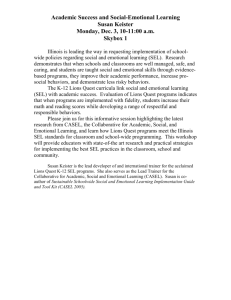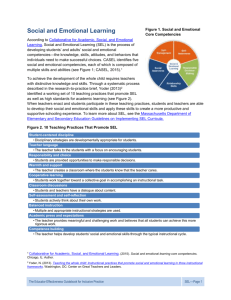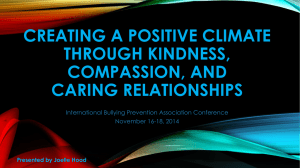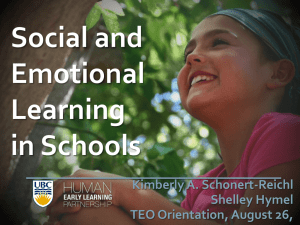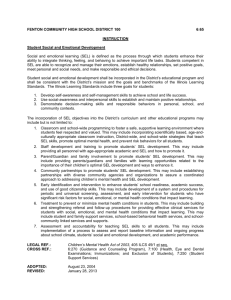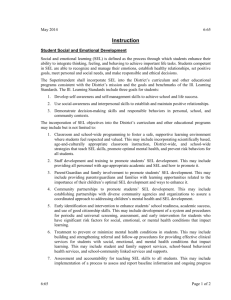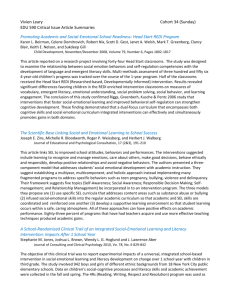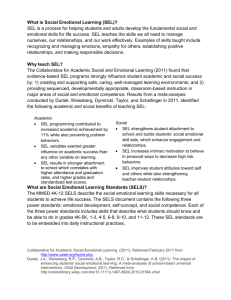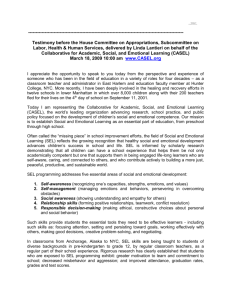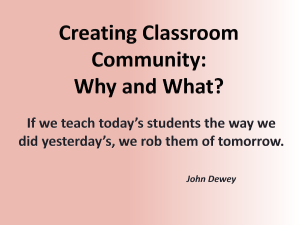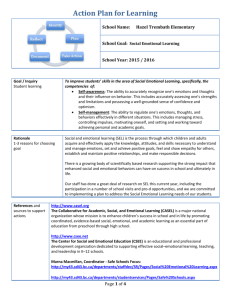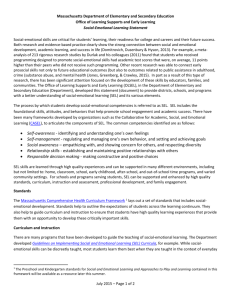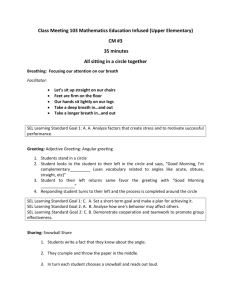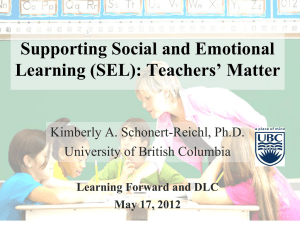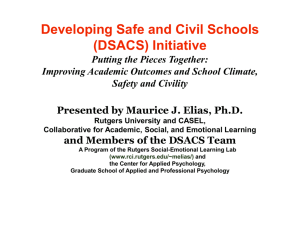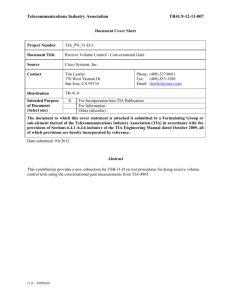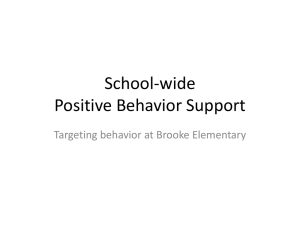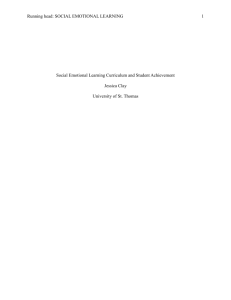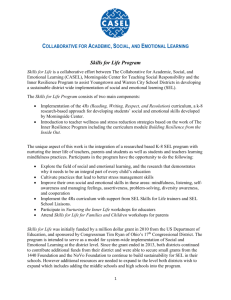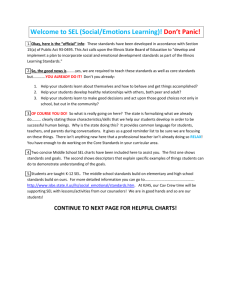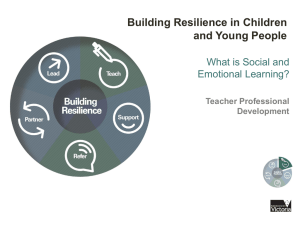PowerPoint - IDEA Partnership
advertisement
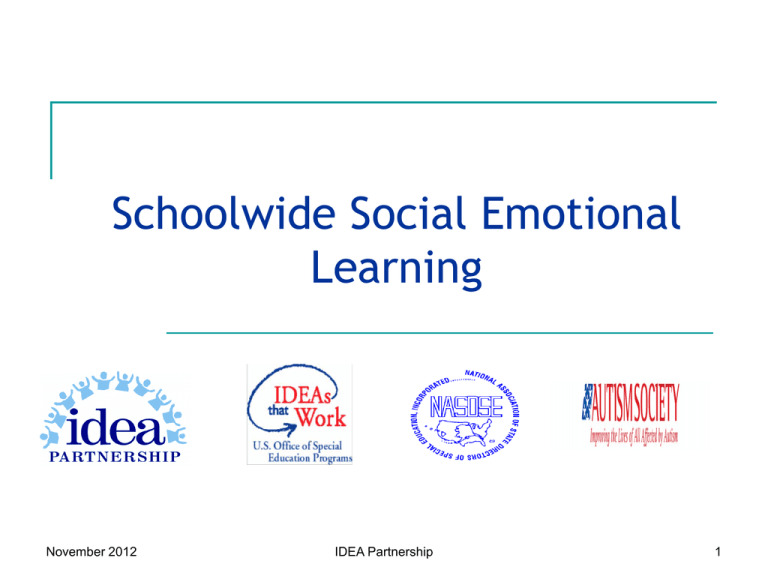
Schoolwide Social Emotional Learning November 2012 IDEA Partnership 1 Jointly Developed By: The Autism Society The IDEA Partnership Project (at NASDSE) With funding from the US Department of Education, Office of Special Education Programs (OSEP) November 2012 IDEA Partnership 2 Development Team The following role groups worked together to create the documents and tools for the ASD Functional Behavioral Assessment presentation: Behavior Analyst Educational Diagnosticians General Education Administrator Higher Education Occupational Therapist Parents November 2012 Person on Spectrum Psychologists Social Workers Special Education Administrator Speech Language Pathologist Technical Assistance Providers IDEA Partnership 3 Outline for Presentation Definitions School-based SEL programs Why schools need to invest in SEL How evidence-based SEL programs work to produce greater student success Social challenges of ASD Supports and interventions at all three tiers Measuring success Educational Definition (IDEA) 34 CFR §300.8(c)(1)(i) “Autism” means a developmental disability significantly affecting verbal and non-verbal communication and social interactions, generally evident before age 3, that adversely affects a child’s educational performance. November 2012 IDEA Partnership 5 Educational Definition (IDEA) 34 CFR §300.8(c)(1)(i) Other characteristics often associated with autism are engagement in repetitive activities and stereotyped movements, resistance to environmental change or change in routine, and unusual responses to sensory experiences. November 2012 IDEA Partnership 6 IEP must include A statement of the child’s present levels of academic achievement and functional performance. (§ 300.320(a)(1) “Functional performance” is a term that is generally understood to refer to skills and activities that are not considered academic, i.e. routine activities of everyday living. November 2012 IDEA Partnership 7 Positive Behavioral Interventions and Supports Must be considered by the IEP Team when a child’s behavior impedes the child’s learning or that of others § 300.324(a)(2) November 2012 IDEA Partnership 8 What is Social and Emotional Learning (SEL)? SEL is a process for helping children and adults develop the fundamental skills for life effectiveness SEL teaches the skills we all need to handle ourselves, our relationships, and our work, effectively and ethically www.casel.org/basics/definition/php November 2012 IDEA Partnership 9 School-based SEL Programs Major skills areas: self-awareness, social awareness, self-management, responsible decision making and relationship skills Multiyear, multicomponent programs are more likely to produce long-term benefits compared to short-term efforts The Illinois SEL standards provide an excellent example of how SEL content and skills can be taught for students in grades K – 12 (www.casel.org) SEL ‘lessons’ are given in small doses and delivered regularly over time in order to help children: Recognize their emotions, think about their feelings and how one should act, and regulate behavior based on thoughtful decision-making Develop positive interaction skills School counseling programs regularly provide such “lessons” November 2012 IDEA Partnership 11 Why do Schools Need to Invest in Social-Emotional Learning? Students today come to school with much more complex social-emotional experiences Students require social-emotional skills to achieve quality of life This also applies to students with ASD The school culture and climate contribute to supporting students academically and socialemotionally November 2012 IDEA Partnership 12 How Evidence-Based SEL Programs Work to Produce Greater Student Success in School and Life CASEL SEL logic model November 2012 IDEA Partnership 13 CASEL Video on YouTube http://www.youtube.com/watch? v=XfyC0o88zfM November 2012 IDEA Partnership 14 A Sample of Expected Social Behaviors in School Environments Working in groups Respecting authority Following directions Talking to other students and adults Adhering to school rules Participating in unstructured activities Participating in extra-curricular activities November 2012 IDEA Partnership 15 The Social Challenges of ASD Making and keeping friends Understanding thoughts and intentions of others Generalizing across environments Code switching—peers, teachers, and administrators Using effective conversational skills Understanding the hidden curriculum cont November 2012 IDEA Partnership 16 The Social Challenges of ASD Distinguishing between public and private behavior Understanding the message behind nonverbal communication Play and leisure skills Working in groups Problem solving and conflict resolution Self-monitoring and self-regulation November 2012 cont IDEA Partnership 17 The Social Challenges of ASD Using effective self-advocacy skills Using special interests Managing sensory needs Adapting to changes in routine Participating in unstructured situations Respecting relational boundaries Practicing good personal hygiene Handling competition November 2012 cont IDEA Partnership 18 Remember that these behaviors must be taught These behaviors must be taught as they relate to different environments throughout the day November 2012 IDEA Partnership 19 Most SEL interventions benefit all students and fit into most environments These are known as universal supports or universal design for learning (UDL) November 2012 IDEA Partnership 20 Students with ASD benefit from supports and interventions at all three tiers Universal Supports: SEL Develop self-awareness and selfmanagement skills to achieve school and life success Use social-awareness and interpersonal skills to establish and maintain positive relationships Demonstrate decision-making skills and responsible behaviors in personal, school, and community contexts November 2012 IDEA Partnership 22 Universal Supports Explicit instruction of the expectations across all environments Reinforcement of expected behaviors Peer-mediated strategies Visual supports Hidden curriculum Class-wide self-regulation strategies Social autopsies November 2012 IDEA Partnership cont 23 Universal Supports Role play Incredible 5-Point Scale Social narratives Stress thermometers Connecting cause and effect Taking personal responsibility Modeling Teaching emotions and how they are expressed appropriately November 2012 IDEA Partnership 24 Secondary and Tertiary Strategies: Beyond Universal Supports Video modeling Stop, Observe, Deliberate, Act (SODA) Social skills groups Cartooning Situation, Options, Consequences, Choices, Strategies, Simulations (SOCCSS) Integrated play groups November 2012 IDEA Partnership cont 25 Secondary and Tertiary Strategies: Beyond Universal Supports Individual self-regulation strategies Self-advocacy Attribution Cause and effect Social translator Family supports Community and wrap-around services November 2012 IDEA Partnership 26 Measuring Success: Universal Supports PBIS checklists Decreases in number of office referrals, suspensions, expulsions Better school wide academic performance November 2012 IDEA Partnership 27 Measuring Success: Secondary and Tertiary Supports Meeting IEP goals and benchmarks Better academic performance Goals attainment scaling November 2012 IDEA Partnership 28 Reflections! Questions? Discussion. November 2012 IDEA Partnership 29
